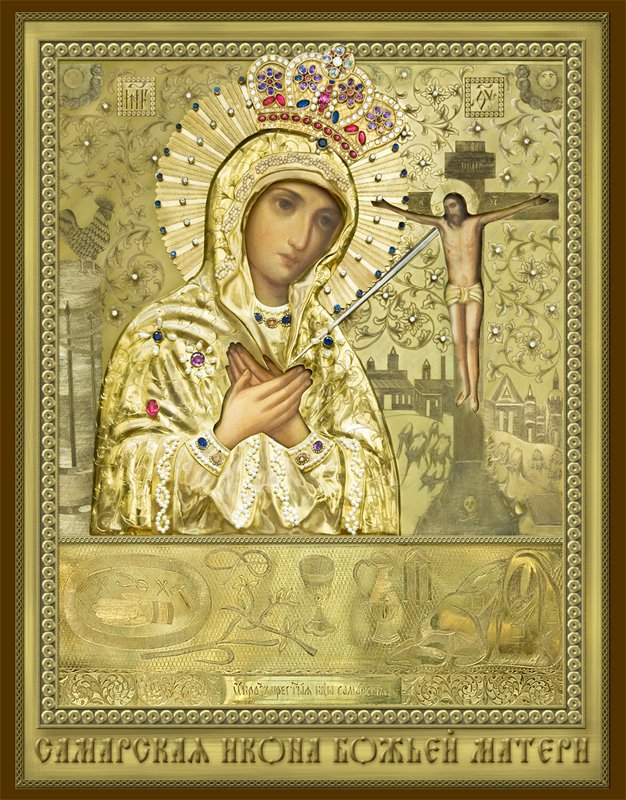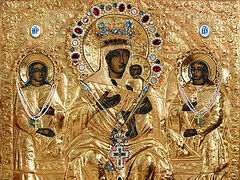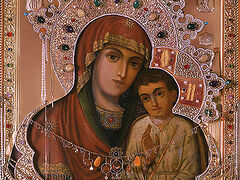 https://samarsky-mon.church.ua/2014/10/ikona-materi-bozhiej-samarskaya/
https://samarsky-mon.church.ua/2014/10/ikona-materi-bozhiej-samarskaya/
Christ is in our midst, dear readers!
Today [September 3, 2022] all the clergy of the Zaporozhye Diocese prayed before the icon of the “Samara” Mother of God—one of the holy shrines of our land. We prayed to the Heavenly Queen that she would protect our city from all enemies and adversaries, that she would save our churches and the lives of the children of her divine Son.
I thought, how much does fear of losing our homes, our lives, or our health motivate the human soul to pray; how the earthly feeling of danger changes people’s lives. Compare your feelings now, when our country is in the throes of war, with those from, say, five years ago. But this is the very problem. We continually forget that in hell it is much worse than in the most horrifying place on the globe. From the Lives of the Egyptian elders we learn that in hell, it is considered a great consolation just to see from afar through the flames, another person. And what terrible and blood-curdling images of hell’s tortures do we find in the revelations of modern saints! But we for some reason do not think about this during times of peace and prosperity. We have no fear of this! But when our physical lives and earthly prosperity are under threat, we immediately get going and pray, seeking help. But isn’t the soul more precious than the body? Isn’t eternal life more valuable than temporary happiness?
Some may say “But we don’t see those torments or those joys that the Lord has prepared for us in the other world.” That’s just it—we don’t see or believe. But Holy Scripture and Tradition tell us about this with full assurance. It is terrible to lose our health and property, but how much more terrible it is to destroy our souls! That is why I am astounded at how cynical and godless one has to be in order to get rich off of the pain and deaths of our own compatriots! We can easily escape the earthly judge, but we cannot hide from the Heavenly Judge. Now, judgment is being passed upon our country; yes, and even over all mankind. I would like to wish for myself and all my readers that we would find justification with God at that judgment, and that having lived out our brief lives, we would enter the heavenly mansions on high.
Metropolitan Luke (Kovalenko)
Telegram
Translation by OrthoChristian.com
***
The “Samara” Icon of the Mother of God, also known as the “Novokaidak” icon. The Protectress of Prednieprovie
Two hundred and seventy-three years ago, an event occurred in the church life of the Dnieper region, which became the starting point in the history of veneration of the extraordinary icon of the Most Holy Theotokos. In 1736, our pious ancestors from the St. Nicholas Church of Novokaidak for the first time began to reverently glorify the image of the Mother of God, which over time went down in history as the “Samara” icon. The holy icon went through many difficult times and it is not known for sure where the original is now. We have tried to trace the history of the icon's origin and its subsequent fate in this publication.
The first reliable written evidence of the locally venerated Novokaidak icon of the Mother of God is contained in the Ekaterinoslav Diocesan Gazette for 1872, No. 18–20. This information was written down by Bishop Theodosy (Makarevsky) of Yekaterinoslav and Taganrog. The essay, “Brief information on the locally venerated icon of the Mother of God" is the first work of the Archpastor published upon his arrival at the Ekaterinoslav See.
The question of the icon’s origin and its appearance in the Novokaidak remains open. To this day, only a widespread Zaporozhye legend has survived, which indicates that this icon was acquired by Cossacks somewhere in the East and brought from there to the Sich [Cossack military base] as a special shrine. In the “History of the Cossacks of Zaporozhye” by Prince Myshetsky it is written that the Cossacks have always—but most of all while under the rule of the Crimean Khans—had a very close relationship with the Orthodox East. They always had a Greek archimandrite with them; monks and priests from Jerusalem and Mount Athos paid visits to collect alms and give various holy relics to the Cossacks. It is only known that the miraculous icon was moved from the Sich to Novokaidak, where in around 1700, a number of events related to the Zaporozhye Sich took place.
First married Cossacks along with their subjects and serfs, began to settle in this rich and safe area, forming, as it were, a link between the Zaporozhye Cossacks and the Samara monastery. Secondly, when the Cossacks left the Sich for Alyosha, all the sick and infirm Cossacks moved either to the Samara Monastery, or to the Novokaidak. One of the Kaidak old-timers, church attendant Semyon Bardadim, left memories that in around 1736 the locally venerated icon stood in the narthex of the former, dilapidated Novokaidak church. However, no one knows exactly who or when the icon was painted, and on what occasion the image of the Most Holy Theotokos was brought to the Novokaidak church,.
Since 1750, Novokaidak took on the status of a city, and the Novokaidak St. Nicholas Church was called a cathedral. When the first miraculous help came from the holy icon that was in this church, it was transferred to the altar, and remained behind the holy altar table. In the 1860s, the icon was already in the altar of the St. Nicholas Novokaidak Church and was revered as miraculous.
In 1768, Cossacks prayed before the icon, going to the Kiev voivodeship at the appeal and invitation of the novice of the Chigirinsky Matreninsky monastery, the famous Maxim Zheleznyak, to defend the Orthodox faith and the Church against the Poles and Catholics. And at the end of the “Uman” military affair, arriving home, in the same Novokaidak church they thanked the Queen of Heaven for a safe return home.
In 1770, rumors about miracles and grace-filled healings from the Novokaidak icon of the Mother of God increased greatly and spread not only to the whole of Zaporozhie, but also to the whole of what is now Ukraine.
Then the icon was ceremoniously moved from the altar to the center of the church, by the right cliros, and installed in a newly-built case. The ataman [Cossack leader] himself donated a silver covering with gold and multicolored stones for the honored icon. The fact that the icon was moved from the altar to a new place was, in fact, the open recognition that it was miraculous.
In 1775, by the orders of Empress Catherine II, the Zaporozhiyan Sich was abolished, and two years later Archbishop Yevgeny (Bulgaris) ordered to place the icon in the Bishop's House, which was located in the Poltava Kresto-Vozdvizhensky Monastery. This is evidenced by the report to the Holy Synod from the Spiritual Consistory on September 2, 1778.
The icon was also transferred from the Poltava Holy Cross Monastery with the relocation of the bishopric to Yekaterinoslav, and in 1804 it was deposited in the Bishop's sacristy.
On August 29, 1807, Hieromonk Joseph, the bishop’s steward and abbot of the Samara St. Nicholas Monastery, asked permission from Archbishop Platon (Lyubarsky) to take two icons from the Bishop's sacristy: the Novokaidak icon of the Mother of God and the ancient icon of St. Nicholas the Wonderworker, and move them to the Samara monastery. The transfer of the icons took place with a large gathering of people in attendance. it is also known that upon arrival at the monastery, the icons were installed in a worthy place.
The general joy of the pilgrims of the Samara Monastery was soon overshadowed by troubles. On May 4, 1808, the clergy of the Dormition Cathedral, headed by the rector of the seminary Archpriest John Bashinsky, petitioned Archbishop Platon (Lyubarsky) to return the miraculous icon of the Mother of God from the Samara Monastery to the Dormition Cathedral. He based his petition on the fact that the Dormition Cathedral is the successor of the Novokaidak Cathedral Church and has already inherited some church utensils and even bells from it. Archbishop Platon decided to satisfy the submitted petition, cancel his own previous resolution, and return the icon. The priest of the Dormition Cathedral, Simeon Chemerisov, went to get the icon, but hieromonk Joseph and the brethren of the monastery would not give release it. After staying in the Samara monastery for several days, he returned with nothing. The inhabitants of the Samara monastery were supported by the local population of Novomoskovsk, who sent an envoy to the bishop with requesting that he leave the icon of the Mother of God in the monastery and call it “Samara” from now on. After long hesitation, His Grace Platon bowed to the request of the God-loving citizens of Novomoskovsk, and on June 23, 1808, issued a corresponding resolution, determining that the icon remain in the Samara monastery. The categorical nature of the resolution, condemning the constant transfer of the holy icon from place to place as impious, put an end to disputes and unrest among both clergy laity. Since then, the icon has served as the adornment and property of a quiet, secluded monastery.
The dimensions of the icon are as follows: Height about 48 cm, width about 40 cm, on a board made of linden wood. The depiction is based upon the Akhtyr Icon of the Mother of God. On the right is the Savior crucified on the Cross, as well as the Jerusalem Temple of Solomon and the sealed tomb. On the left is a pole wrapped with ropes, a spear and a staff, with a rooster on top of the pole. On the right side is the sun, on the left is the moon. The icon also depicts the instruments of Christ’s Passion: nails, a hammer, tongs, a thorny branch, a jug, a bowl, a lantern, a robe, and a crown of thorns. The image on the icon is darkened and burnt in places. Currently, there is an inscription on the icon: “1) This icon of the Most Holy Theotokos has been well known since 1736. 2) Consequently, a hundred years have elapsed since that time until now (thus, the inscription was made in 1836). 3) The face of the holy icon was darkened from a fire, which it survived.”
After the revolution of 1917, the Samara monastery was closed and information about the icon was lost. Whether the original of the miraculous icon has been preserved or destroyed, no one can say for sure. Employees of the Historical Museum of Dnepropetrovsk claim that the ancient icon is currently in their storage archives. Believers are inclined to assume that having passed through the dark years of persecutions against the Church and the hardships of wars, the image is now located in the city’s Holy Trinity Cathedral. In the catholicon of the Samara St. Nicholas Monastery there is an exact copy of the icon.
According to the resolution of the Holy Synod of the UOC of March 12, 1998, the celebration of the locally venerated “Samara” Icon of the Mother of God falls on November 6. This is a brief history of the miraculous icon of the Mother of God of Novokaidak, which later became Samara.
From an article by Deacon Giorgi Skubak
Translation by OrthoChristian.com
Dniepropetrovsk Diocese, UOC



